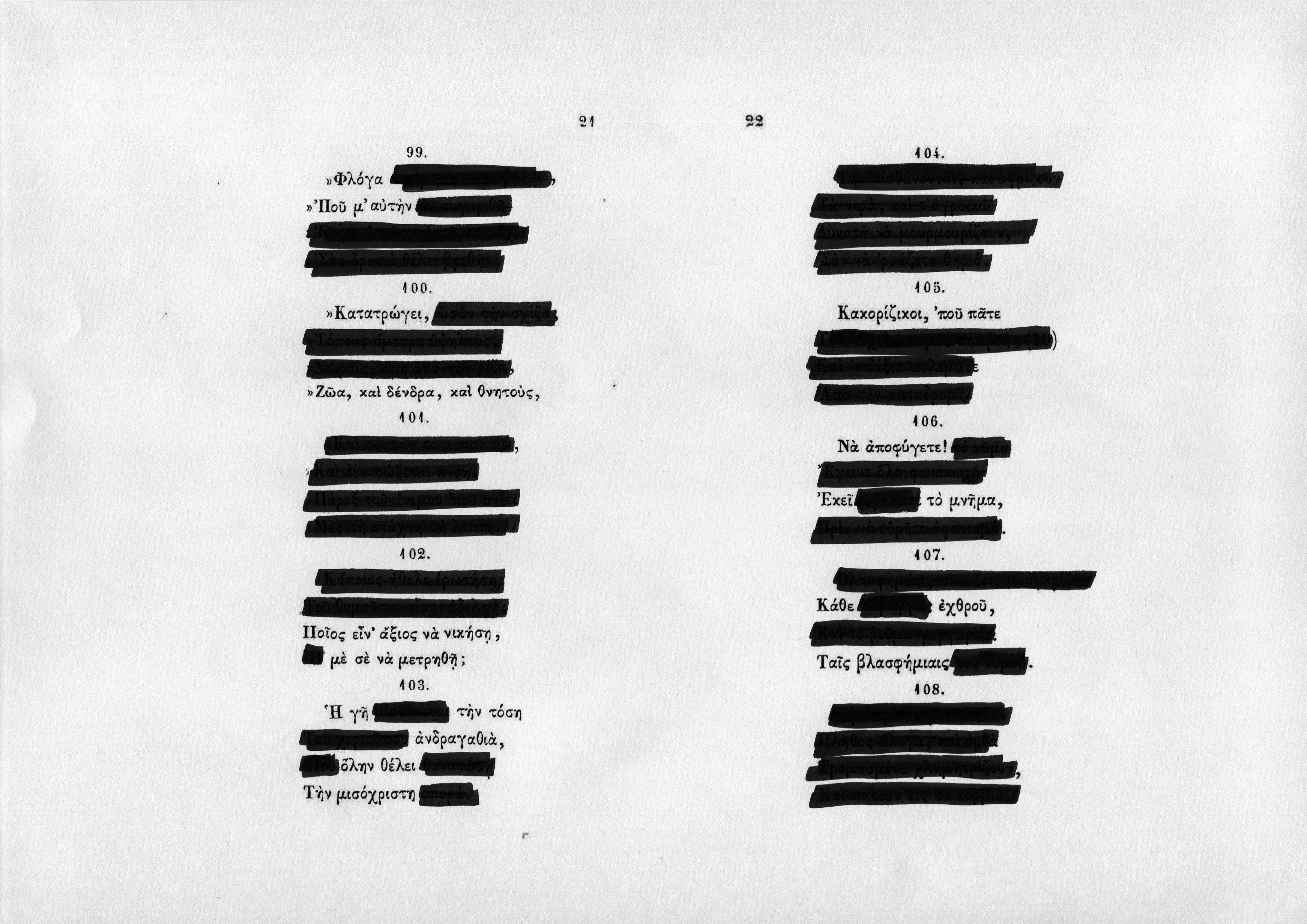


















Ode to Mourning, 2020
16 photocopy prints on paper. dimensions 21 x 29.7 cm each
16 photocopy prints on paper. dimensions 21 x 29.7 cm each
At 158 stanzas (632 verses), the “Hymn to Liberty”,
Greece’s national anthem is the longest state anthem in the world by length of
text. Written by Dionysios Solomos in 1823, it was officially adopted as the
national anthem of the newly established Greek State in 1865. It is also the
only anthem that is shared by two countries, as Cyprus made “Hymn to Liberty”
its national anthem in 1966.
Inspired by the 1821 Greek Revolution, Solomos created a poetic ode to honor the Greek struggle for independence after centuries of Ottoman rule. The poem, which combines elements of romanticism and classicism, portrays the spiritual and physical torment of the goddess of Liberty —both a literal allegory and a representation for the Greek people— as she contemplates the fate of the nation. Imbued with symbolisms and references from the long and illustrious Greek history, accounts of heroic sacrifice, and the archetypal pathos between good and evil, the poem is set against an evident religious testament to Christianity and sanctity. The first two stanzas of the poem —the only part that is used as the national anthem—, begins with a heroic affirmation of Hellenism drawing parallels to a “fearsome sword”, to bravery and honorable death.
Inspired by the 1821 Greek Revolution, Solomos created a poetic ode to honor the Greek struggle for independence after centuries of Ottoman rule. The poem, which combines elements of romanticism and classicism, portrays the spiritual and physical torment of the goddess of Liberty —both a literal allegory and a representation for the Greek people— as she contemplates the fate of the nation. Imbued with symbolisms and references from the long and illustrious Greek history, accounts of heroic sacrifice, and the archetypal pathos between good and evil, the poem is set against an evident religious testament to Christianity and sanctity. The first two stanzas of the poem —the only part that is used as the national anthem—, begins with a heroic affirmation of Hellenism drawing parallels to a “fearsome sword”, to bravery and honorable death.
Yet as the poem unfolds, we witness a descend into a gloomy
narrative of national agony, a national self-torment, where, despite its
Christian virtue and honor, the nation is abandoned by the powerful other.
This narrative, a national mourning of sorts which lingers between a grandiose
glorification of a historical past and a lamentation on what the nation could have been, ironically still defines the contemporary national social stance
in both Greece and Cyprus.
Cerulo defines national anthems as “official patriotic symbols-the musical equivalent of a country's motto, crest, or flag. As such, they represent the nation's identity or character-its mood, desires, and goals as put forth by those in power”[1]. They act as crucial symbolic poems that mainly provide internalization of certain social shared values that can potentially define national sentiment. Despite the historical space in which Solomos’ poem was created, and while taking in account modernity’s views on nation and nationalism, two hundred years on, the “Hymn to Liberty” still articulates —and has probably affected— the Hellenic national identity.
[1] Cerulo, K. A. (1989). “Sociopolitical Control and the Structure of National Symbols: An Empirical Analysis of National Anthems”. Social Forces, 68(1), 76-79.
Cerulo defines national anthems as “official patriotic symbols-the musical equivalent of a country's motto, crest, or flag. As such, they represent the nation's identity or character-its mood, desires, and goals as put forth by those in power”[1]. They act as crucial symbolic poems that mainly provide internalization of certain social shared values that can potentially define national sentiment. Despite the historical space in which Solomos’ poem was created, and while taking in account modernity’s views on nation and nationalism, two hundred years on, the “Hymn to Liberty” still articulates —and has probably affected— the Hellenic national identity.
[1] Cerulo, K. A. (1989). “Sociopolitical Control and the Structure of National Symbols: An Empirical Analysis of National Anthems”. Social Forces, 68(1), 76-79.